From Promise to Payoff
Our sixth annual pipeline report details 44 drugs that industry will be talking about in 2010.
After five years of in-licensing drugs and buying biotech companies outright, Big Pharma's shopping spree may be finally moving from promise to payoff. The new drug applications (NDAs) submitted by the Pfizers and Mercks of the world are increasingly for out-of-house discoveries to which the world's biggest drugmakers biggest contribution is bankrolling, designing, and executing late-stage clinical trials.
This trend is nowhere more dramatic than in oncology. Major companies are poised to profit from Cougar Biotechnology's albiraterone, a promising therapy for hormone-refractory prostate cancer, Medarex's ipilimumab, a potential blockbuster in hard-to-treat malignant melanoma, and PARP inhibitors by BiPar and KuDOS Pharmaceuticals.

"There hasn't been much to show for the last five years," said Barbara Ryan, managing director and pharma analyst at Deutsche Bank. "It's time to look for the fruits of those collaborations. There is a glimmer of hope that the payoffs may now become apparent."
On the whole, buying promising pipeline candidates has yet to result in more—or more successful—NDAs. IMS Health, a healthcare information and consulting company that charts NDAs, does not expect the number of new launches to begin climbing back toward 50 a year. (It peaked at 49 in 1997.) "We believe the range for 2010 will stay the same as it is for 2009," said Anthony Riggio, a spokesperson for IMS. The company sees 25 to 30 launches in 2010. Only 25 new drugs were launched in 2008.
That said, the 2010 pipeline promises therapeutic advances and, here and there, a potential blockbuster. Of the 44 Phase II and III compounds, several merit special mention. Denosumab, Amgen's versatile monoclonal antibody, offers hope for metastatic cancer patients as well as people combating bone disease. Four late-stage Factor Xa inhibitors are racing to replace the blood thinner warfarin, one of the oldest and most widely prescribed medications in the world. And multiple sclerosis patients can see an oral therapy on the horizon.
The most notable absence is in the CNS diseases, a.k.a. the "black box" of drug R&D. As the current disarray in the Alzheimer's pipeline illustrates, neuroscience has a great deal left to learn about the fundamental workings of the brain before truly disease-modifying drugs are developed.
Our 2009 Pipeline Report take-home? It may not be an age of bounty in the pharmaceutical industry—but it is a time of hope.
STROKE/ACUTE CORONARY SYNDROME
Difficult field sees first advances in many years
Antithrombotic drugs balance patients on a tightrope between two risks: blood clots and coagulants. Fall off on one side and thrombosis and stroke threaten; slip in the other and surgery is dangerous because of uncontrollable bleeding. For decades, warfarin has been just about the only drug to keep patients in balance. Now, a few possible successors are moving toward pharmacy shelves.
The desire to supplant warfarin has little to do with its efficacy as a blood thinner. Problems usually center on excessive bleeding and interactions with common drugs and foods, including aspirin derivatives, certain vitamins, and alcohol. "Any drug that posed a lesser risk of excessive bleeding while preventing clotting equally well would take patients from warfarin," says Nikhil Mehta, who heads the Cardiovascular and Metabolic Division at Decision Resources.

In Phase III data presented in August, Boehringer Ingelheim showed that a higher and a lower dose of dabigatran (Pradaxa), which inhibits thrombin directly, were superior to warfarin for patients with atrial defibrillation, a heart arrhythmia frequently associated with strokes. The higher dose was more efficacious than the lower, but both doses were safer when it came to unwanted, uncontrolled bleeding. "People with a high risk of bleeding can get the lower dose. People at higher risk of stroke can receive the higher dose," Mehta says.
A novel class of factor Xa inhibitors is also in the race for better oral anti-thrombotic therapies. These compounds works by inhibiting the catalyst, factor Xa, for the cascade that converts prothrombin into thrombin and thereby stimulates blood clotting. Slowing the catalyst slows the clotting process. Apixaban is expected to be approved for atrial fibrillation. "A-fib will be the first indication, we think, for apixaban—straight prevention in a-fib patients," says Mehta.
Another member of the class, rivaroxaban (Xarelto), has been launched for the prevention of post-surgical thromboembolism in Canada and Britain, but as with apixaban, the high stakes are riding on Phase III trials in acute coronary syndrome. If that indication is approved, the drugs will compete for a huge market. "We're predicting there will be room for both compounds—and in fact follow-on agents—in the market," says Mehta, who pointed to edoxaban as the next promising factor Xa inhibitor up the pipeline. "Both Pradaxa and Xarelto will hit that magic $1 billion number and become blockbusters."
Edoxaban is being developed by Daiichi Sankyo. The company announced in July that it was reshaping its Phase III design in light of new data showing that a single dose of the compound caused fewer adverse bleeding events than two doses—trough levels of the drug, not high peak levels, govern bleeding.
Further back in the pipeline are two compounds from hot biotech Portola Pharmaceuticals, which scored two major deals with big pharmas this year for two Phase II compounds. Merck bought its factor Xa inhibitor, betrixaban, for nearly $500 million in milestone payments. Novartis nabbed Portola's elinogrel, an adenosine diphosphate (ADP) receptor antagonist that aims to prevent thrombosis and heart attack in patients with acute coronary syndrome. The Swiss firm paid $75 million upfront and an undisclosed amount in milestones.
One of the major launches of 2010 in terms of potential sales is likely to be AstraZeneca's ticagrelor (Brilinta). This new antiplatelet is aimed squarely at the market for acute coronary syndrome, one of the largest cardiology markets in the world.
Because the need for antiplatelet agents is less acute than the need for new anticoagulants, drugs like Brilinta may not take off as fast as a new drug that proves superiority to warfarin. But head-to-head data comparing Brilinta to market leader Plavix presented at the American Heart Association meeting last month showing that Brilinta has clear clinical superiorities to the BMS/Sanofi megablockbuster. In the 18,000-patient study, the Brilinta group had fewer heart attacks and a lower death rate than the Plavix arm. The study had one unexplained statistical anomaly: The 9 percent of patients enrolled in North America showed no benefit over Plavix. Brilinta also appears to work faster than Plavix, and its effects are easily reversible. "If the doctor decided within a short window of time that they wanted to perform some sort of interventional surgery, they wouldn't have to worry about the long duration of the drug," says Barbara Ryan.
Some cardiologists see the new drug replacing Plavix, which boasts more than $9 billion in annual sales. (But Plavix already faces generic competition in Europe and will face it in the US in 2012.) Still, Physicians might hesitate to use Brilinta, since it must be taken twice a day instead of once. "That doesn't sound like much of a difference," says Mehta. "But there's that potential for someone to have an MI [myocardial infarction] if they're not very compliant."
MULTIPLE SCLEROSIS
The race for the first oral treatment
In the treatment of multiple sclerosis, advances in convenience or tolerability can make a big difference in sales. Interferon beta 1-a (Avonex from Biogen Idec) is an established therapy for MS relapse prevention and, in the US, a first line treatment for newly diagnosed patients. In a new pegylated form, patients can look forward to fewer, less painful injections. Avonex is currently injected once a week in a doctor's office. The new longer lasting drug will not require the same large-bore needle for intramuscular injections. Instead, patients will give themselves a subcutaneous shot every other week or perhaps once a month. "We expect it do very well, with sales of about $1.5 billion by 2018," says Andrea Witt, an analyst at Decision Resources.
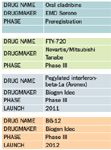
Even as current patients look forward to self-injections, drugmakers are racing to launch the first oral MS drug in this $8.6 billion IV-only market. Oral cladribine, a new formulation of anti-leukemia injectible Leustatin from EMD Serono, an affiliate of Merck KGga, was leader of the pack until FDA issued a "refuse to file" letter in November, which puts all market plans on hold. The chemical promises better efficacy than the interferons but worrisome side effects, including headache, upper respiratory tract infections, and nausea. "Oral cladribine will have efficacy between these two broad classes of drugs—better than the interferons and Copaxone, but not as good as Tysabri," Witt says. "However, it will have the oral formulation—but with the bad side effects, it's not going to be a first line therapy."
Witt sees Novartis's FTY-720 (fingolimod), the new front-runner, doing about as well as oral cladribine, and for the same reasons. "It has efficacy very similar to cladribine, and the same side-effect profile," she says. "Just a little risky, so it won't be first line." But given the advance in convenience offered by an oral drug, she expects both drugs to reach blockbuster status by 2015.
Biogen Idec's oral candidate, BG-12, is expected to conclude its main Phase III trials in mid -2010, although an extension trial, will assess the drug's safety and efficacy over two years. Teva and Sanofi-Aventis also have promising oral MS compounds in early Phase III.
In the short term, look for injectibles, perhaps more convenient ones, to dominate the market. But in the long run, effective oral therapies are on the way. The next challenge will be differentiating among the new crop and determining which treatments work best for which patients, given how disparate their range of symptoms can be.
HEPATITIS C
Two kinder, gentler oral drugs for a fierce virus
Sometimes being first to market is not only the best thing but the only thing.
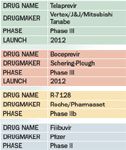
Two new protease inhibitors, telaprevir and boceprevir, are competing to be the first compound added to the current standard of care—a cocktail of pegylated interferon and ribavirin—in order to reach the more than half of all patients with hepatitis C (HCV) who do not respond.
The stakes are higher than usual for drugmakers in a race to approval because the rate of incidence of new cases of HCV in the US has dropped sharply over the past decade due to public education and needle exchanges, according to the CDC. If current nonresponders are cured, the patient pool is expected to remain small. "Whoever you have right now, you have to treat," says Alexandra Makarova, an analyst at Decision Resources. "But then you will not have the influx of extra new patients. It's so key to get there first." ThinkEquity LLC analyst Jason Kolbert estimates the market for hepatitis C treatments at about $2.5 billion a year and—oddly, given the projected decline in patients—estimates that it will quadruple over the next decade.
These protease inhibitors will be the first oral, small molecules to show an effect on HCV. The two have similar but not identical mechanisms of action—they are based on different peptide chains but attack the same protease enzyme—and are expected to launch in 2012, according to the WoltersKluwer. Telaprevir is about six to eight months in the lead.
Further back in the pipeline other protease inhibitors are percolating, including TMC435 from Johnson & Johnson, SCH900518 from Schering-Plough (now Merck), and MK7009 from Merck, but the firms may decide to pull the plug if the market diminishes.
Another experimental class of HCV drugs, polymerase inhibitors, may be at least as efficacious as the protease inhibitors and have fewer side effects. They include R-7128 from Roche/Pharmasset and filibuvir from Pfizer. The new compounds also promise dosing advantages, a shorter course of therapy, and, therefore, greater patient compliance. But the firms may choose to pull the plug on the drugs if too few patients remain in the pool to reap profits. "These are better drugs," says Makarova. "But they're just too late."
ONCOLOGY
So many targets, so little time
Denosumab (Prolia), Amgen's anti-osteoporosis monoclonal antibody, is also in late-stage tests for the treatment of bone metastases related to cancer. The drug targets RANK Ligand, one of the proteins active in osteoclasts, which destroy bone cells. Metastatic activity can result in so-called skeletal-related events (SREs), including bone fracture, radiation to bone, surgery to bone, or spinal cord compression. In a 2,000 patient Phase III trial, denosumab proved superior to Novartis's zoledronic acid (Zometa) in preventing SREs and delaying increases in bone pain.

Amgen needs a blockbuster badly. Yet denosumab faced a setback in October when FDA delayed approval for indications for bone loss in breast and pancreatic cancers; the bone-metastasis indication has yet to come out of the advisory board. Tolerability may be the biggest selling point for the new drug. Says Fleur Pijpers, an analyst with Datamonitor: "When patients receive Zometa, they have to have their kidney function monitored quite regularly. Denosumab doesn't need that. And it's got a more convenient administration by subcutaneous injection.

Sales for denosumab in all uses, including osteoporosis, could reach $5 billion in 2015, Geoffrey Porges of Sanford Bernstein told the Wall Street Journal. Other analysts project sales of 30 percent less. Projections vary in part because Amgen has not said how it will price the drug, although an annual price tag of $1,500 to $2,000 is expected.
Ipilimumab, a novel monoclonal antibody that blocks the effects of the negative T cell regulator CTLA-4, targets malignant melanoma, prostate cancer, lymphoma, and lung cancer by strengthening the immune response to tumor cells. "Bristol liked this drug so much that they bought the company," says Les Funtleyter of Miller Tabak. BMS paid $2.1 million for Medarex, a boutique specializing in monoclonal antibodies— a hefty pricegiven that Ipilimumab's peak sales aren't due to exceed $400 million. Another Medarex anti-CTLA-4, tremelimumab, was discontinued by Pfizer in Phase III against malignant melanoma after the drug failed to show superiority against available chemo. It is still being tested in phase II prostate and bladder cancers, among others.
Lilly's Enzastaurin is the most advanced of the PI3K inhibitors, a relatively new class of drugs that exploit a pathway in the familiar antiangiogenic approach to tumor control. "Everybody has a PI3K drug—it's a big pathway," Funtleyter says. By interfering with PI3K in the protein kinase B signaling pathway, enzastaurin increases the permeability of the mitochondrial membrane, which can result in apoptotic cell death. Lilly got the jump on the competition, few of which have adanced beyond Phase I. Enzastaurin is in Phase III trials for non-Hodgkin's lymphoma and in eight Phase II trials for other types of tumors.
Abiraterone is a potential second line therapy for prostate cancer. The drug showed good results in Phase II studies on tumors in patients who had not received chemotherapy, and also in patients resistant to hormone therapies that caused the testicles to stop producing testosterone. Experts believe that these tumors continue to grow because they can feed on testosterone produced elsewhere in the body or by the tumor itself. "What is most striking is that it seems to have an anti-tumor effect in refractory or resistant patients," Pijpers says, noting that it starves tumors because it inhibits an enzyme necessary to the production of testosterone anywhere in the body.
Abiraterone was discovered by the Institute of Cancer Research in London and licensed to Cougar Biotechnology. Johnson & Johnson acquired the drug by purchasing the cancer biotech for $870 million in July. Datamonitor estimates abiraterone's peak sales to reach almost $900 million for all potential indications, while Decision Resources projects prostate cancer sales to reach over $500 million in 2018.
Another new class of cancer drugs is known as PARP inhibitors. The PARP, or Poly (ADPribose) polymerase, enzyme regulates gene transcription and repair, especially in cancer cells, so blocking it slows cell growth. At the recent meeting of the American Society of Clinical Oncology, the two leading PARP inhibitors—BSI-201 from BiPar and Sanofi-Aventis and olaparib from KuDOS and AstraZeneca—released eye-catching Phase II data. "It's quite rare for drugs to create such a buzz just based on the Phase II data. So these certainly make you sit up and notice," says Pijpers.
In BSI-201's Phase II trial, researchers treated triple-negative breast cancer. One in seven breast cancer patients falls into this highly unmet need group. As HER2 negative patients, they cannot be treated with a variety of hormone therapies, even though they have a hormone-driven disease. "In this trial," Pijpers says, "BSI-201 was combined with Gemzar and carboplatin. Researchers reported an improvement in progression-free survival of 6.9 months compared to 3.3 months in the chemotherapy arm."
Provenge, Dendreon's prostate cancer vaccine, first attracted attention in this report at least five years ago. At the time, experts were predicting a 2007 launch, but now the drug may finally be ready for its FDA close-up. The first-in-class vax fuses cellular components from the patient's own immune system onto the sort of dendritic cell that typically presents an antigen. The vaccine is acting as a guided missile that shoots down prostate cancer cells. The dendritic cell carries prostate-specific antigen PSA, an enzyme that occurs with prostate cancer, and an agent that stimulates the growth of white blood cell colonies that fight the disease.
"It's a personalized cancer therapy—a completely new idea of using a patient's immune system to fight cancer," says Tom Gray, an analyst at Datamonitor. "And it would be the first therapeutic cancer vaccine to reach the market." Data released in April showed that the vaccine increased the length of median overall survival of mildly symptomatic metastatic resistant prostate cancer patients to 25.8 months compared to 21.7 months for placebo.
Two big questions that may cause Provenge to disappoint: Is FDA, which has says it will decide the vaccine's fate by May 1, privy to any negative data that has gone unpublished? And just how much personalization is a good thing? "It may be really increasing the level of inconvenience for the patient," Gray says, "Where you have an off-the-shelf drug like Taxotere that you can give to the patient then and there as opposed to having to waitmaybe a week to administer the vaccine." Datamonitor estimates Provenge's peak sales at $300 million plus change, while Decision Resources sees blockbuster status—$1.1 billion in 2018.
ASTHMA/CHRONIC OBSTRUCTIVE PULMONARY DISEASE
A surge of new combination therapies of new (and not-so-new) drugs
The chronic obstructive pulmonary disease (COPD) market is on track to nearly double by the end of the coming decade. In 2008, COPD was a $7 billion market worldwide. By 2018, the market will reach $11.5 billion, according to Amy Whiting, an analyst at Decision Resources. At the same time, none of the drugs currently on the market—and, more surprisingly, none set to launch by 2018—are disease-modifying or improve lung function over the long term, Whiting says.

Innovation remains incremental in this space. And since bronchodilators are almost always combination therapies, the trend among drugmakers is to combine a newly formulated compound to with one the firm is already marketing. The benefits for patients are convenience in dosing. The challenge for pharmas will be to differentiate these combinations in the marketplace.
Indacaterol, a long-acting beta-2 agonist (LABA), promises a 24-hour effect as a bronchodilator—about twice as long as most current LABAs. It's a component of two new experimental compounds, both from Novartis. Combined with the anti-inflammatory mometasone, an inhaled corticosteroid (ICS), the drug is known as QMF 149. In combination with the bronchodilator glycopyrrolate, a long-acting muscarinic antagonist (LAMA), the drug is called QVA 149. Both drug combinations are completing Phase II trials. Analysts, including Whiting, see these fast-acting, once-daily treatments as blockbusters in the growing market.
The Novartis LABA/LAMA combo faces competition from Forest's Aclidinium, a new LAMA being tested in combination with the widely marketed LABA formoterol. The most promising new LABA/LAMA combination, according to Whiting, pairs the Boehringer Ingelheim LABA component, BI-1744-CL, with the LAMA tiotropium, marketed in the US as Spiriva. "As far as combined US and European sales, we expect that to be over $1.2 billion in 2018," Whiting says.
Competing with Novartis's QMF 149, GlaxoSmithKline and Theravance are running Phase III tests of GW 642444, a new LABA, with fluticasone furoate, an ICS. "That would be the most promising, as far as the emerging LABA/ICSs," Whiting says. She projects peak sales of $815 million in 2018.
Many of these drugs may be available as monotherapies, but the combinations are the future of this sector. Says Whiting: "We expect three new LABA/LAMA combinations to garner nearly 20 percent of the 2018 COPD markets. So they are going to take share away from some of the currently available LABAs and LAMAs that may be prescribed individually."
In addition to bronchodilators like the LABAs and LAMAs, COPD can be treated with anti-inflammatories, including the class of phosphodiesterase 4 inhibitors, such as roflumilast, an oral once-daily from Forest and Nycomed. The firms have already filed an NDA under the name Daxas in Europe and in the US. Whiting expects the drug to launch in Europe but says she is "hesitant about its place in the United States" because FDA will look askance at the gastrointestinal side effects and weight loss that have plagued patients in clinical trials. The cautious physician may use it as an add-on to bronchodilator therapy.
ANESTHESIA
A novel approach shakes up the established order
When patients come to even after a minor surgery, their safety and comfort depend in part on the timely reversal of the effects of muscle relaxants used in anesthesia. Indeed they can't check out of the hospital until the muscle relaxants administered by the anesthesiologist wear off. Several issues come into play, from a patient's discomfort or fear at feeling paralysis to the hospital down time involved. Patients want to feel better and leave. Hospitals need their beds.

Sugammedex (Bridion) is a selective relaxant binding agent developed by Organon Biosciences to reverse the neuromuscular blockade that follows surgery done under muscle relaxants such as rocuronium bromide and vecuronium bromide. (Organon was acquired by Schering-Plough in 2007.) Current agents that reverse the effects of muscle relaxants include neostigmine, which is eight or nine times slower than suggamedex, according to its maker, Merck/Schering. "It's the first new drug for 30 years and anesthesiologists are excited for it," says Deutsche Bank's Barbara Ryan.

RHEUMATOID ARTHRITIS/GOUT
Pfizer may have a big blockbuster at last
A potential treatment for rheumatoid arthritis (RA), Pfizer's oral immunosuppressant, CP 690550, goes to the root of the disease, according to Deutsch Bank's Barbara Ryan. This small-molecule compound would be cheaper than many competing biological therapies as well as an advance in convenience over anti-RA injectibles, such as tumor-necrosis-factor inhibitors.
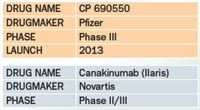
CP 690550 is a Janus kinase 3, or JAK-3, inhibitor—and the first to make it into late-stage development. JAK-3 is an enzyme that governs the passage of cytokines, cellular proteins released to signal other cells, from the outer wall of the receiving cell across the cell membrane. This pathway plays a role in governing immune responses and inflammation, which are important elements of flare-ups in RA, MS, and other immune disorders.
A Phase III trial, due to be complete in 2012, is enrolling 750 patients with moderate to severe RA. They will add two different doses of CP690550 to their weekly methotrexate therapy (the standard of care) vs. a methotrexate-only group, according to WoltersKluwer.
In a smaller study in Japan, researchers found that at least half of patients receiving a variety of doses of CP 690550 with methotrexate reached the endpoint of ACR 20 (a 20 percent improvement in tender and swollen joint counts) at week 12—a statistically significant faster rate than patients on only methotrexate, according to Pfizer. Efficacy was better at higher doses. "If the safety and efficacy hold up," says Ryan, "it could certainly be worth billions of dollars, given the size of the current market."
Canakinumab, an injectible monoclonal antibody that Novartis launched as Ilaris this year for cryopyrin associated periodic syndromes (CAPS)—a rare form of chronic recurring inflammation—is also being tested in Phase III against rheumatoid arthritis and in Phase II against gout. Patients with early RA receive IV canakinumab or placebo plus oral methotrexate. "The drug was launched for a minor indication," says Miller Tabak's Funtleyder. "It would have a big impact if it is approved for RA or gout."
Canakinumab looks to be more effective against acute flare-ups of gout than triamcinolone acetonide, a commonly used antihistamine. In a Phase II trial with 191 patients contra-indicated or refractory to NSAIDs, pain relief came in one day rather than two, and the intensity of pain declined more under canakinumab, according to WoltersKluwer. More important, the probability of recurrent gout flare-ups was 3.7 percent with canakinumab vs. 45 percent with the antihistamine.
TYPE 2 DIABETES
A new class for an exploding epidemic—and a Januvia rival, finally!
In a space crowded with "me-too" products aiming at a rapidly expanding patient population, one new class of drugs stands out. The SGLT2 inhibitor dapagliflozin is a joint project by Bristol-Myers Squibb and AstraZeneca, with BMS controlling the US rights and AZ the rest. An oral drug, dapagliflozin tackles two problems plaguing insulin-dependent patients: weight gain and hypoglycemia.
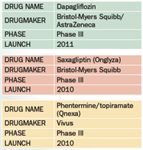
"It's a good add-on option for patients whose condition is not being controlled with current therapies," says Christine Helliwell, an analyst at Decision Resources. "We think this is going to be the next blockbuster diabetes class."
The sodium glucose transporter protein (SGLT2) governs glucose reabsorption in the kidneys, helping retain glucose for the body's energy requirements. For patients with diabetes, retaining glucose via the SGLT2 pathway contributes to high blood sugar levels; blocking SGLT2 leads to the excretion of glucose in the urine, preventing it from being turned into fat by insulin. Although there are side effect concerns, including urinary tract and genital infection, preliminary Phase III data released in October remain encouraging, Helliwell says. The adverse events were mild to moderate and did not result in patients quitting the study, according to WoltersKluwer.
Nine different companies have SGLT2 inhibitors in Phase I or II, but only Sanofi-Aventis and Boehringer Ingelheim are likely to have the sales force to market a drug of this size without a partner. The rest are small pharmas or biotechs; they are looking at in-licensing or even takeovers by Big Pharmas, should dapagliflozin do well.
But new diabetes agents face an uphill battle at FDA—especially regarding cardiovascular signals—following questions raised about safety standards sparked in 2007 by the controversy over heart attack risk associated with GSK's Avandia. "I think the evolution of new agents has been fairly clear over the last decade, but the bar going forward is a pole vault," Barclays Capital analyst Tony Butler told Reuters.
Meanwhile, Merck's first-in-class DPP-4 inhibitor, sitagliptin (Januvia), is about to get some competition after taking the Type II diabetes market by storm over the past three years. The WoltersKluwer site lists nearly two dozen compounds in this class that are making their way through the pipeline. The drugs inhibit the enzyme dipeptidyl peptidase 4 (DPP-4), which breaks down the gastrointestinal hormones released in response to a meal, which in turn stimulates the secretion of insulin and suppresses the release of glucagon, the hormone that tells the liver to convert glycogen to glucose. Blocking this enzyme prevents the body from overcompensating in either direction by overproducing insulin or glucagon.
The next DPP-4 inhibitor to reach the US market, according to Helliwell, will be saxagliptin, which Bristol-Myers Squibb plans to launch under the name Onglyza late in 2010, following its FDA approval in July.
"It looks clinically very similar to Januvia," Helliwell says, "So it really is going to come down to marketing." Given the expected strong marketing push behind the drug, and the trailblazing effects of Januvia, Helliwell forecasts another blockbuster.
Finally, Helliwell likes the chances of Vivus' Qnexa, a novel phentermine/topiramate combination (both drugs are already on the market). "It's really the only drug that can hit the benchmark of 10 percent weight loss in a large portion of patients," Helliwell says. "For diabetes, it also significantly reduces the HbA1C, so you can see why physicians would be interested in prescribing a drug like that for patients for whom serious weight loss would be a significant benefit."
ANTI-INFECTIVES
Two new candidates against the growing threat of MRSA
Any new drug to treat MRSA (methicillin-resistant Staphylococcus aureus) must be measured against vancomycin, a cheap, effective drug that works against the scourge of hospitals and, more recently, the general community. No matter how often a MRSA strain mutates, it has failed to become resistant to the 50-year-old workhorse, vancomycin.
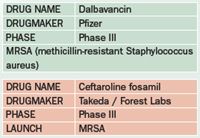
Despite success in head-to-head trials against vancomycin, Pfizer withdrew its NDA and its European MAA for dalbavancin last year. Discussions with regulators convinced Pfizer to put its new glycopeptide antibiotic through an additional Phase III trial for complex, MRSA-related skin infections. The drug remains a strong candidate, however, not least because its once-a-week IV dosing is a significant promoter of patient compliance.
Ceftaroline fosamil, by Takeda and Forest Labs, promises to kill not only gram-positive bacteria like MRSA but gram-negative organisms as well. Formulated as a pro-drug to increase its water solubility, the new compound is a cephalosporin, a family of drugs including penicillin that kill bacteria by interfering with cell wall synthesis. Doctors have trusted this family of drugs for decades, but until recently none had been found that were effective against MRSA.
Addressing Disparities in Psoriasis Trials: Takeda's Strategies for Inclusivity in Clinical Research
April 14th 2025LaShell Robinson, Head of Global Feasibility and Trial Equity at Takeda, speaks about the company's strategies to engage patients in underrepresented populations in its phase III psoriasis trials.
Beyond the Prescription: Pharma's Role in Digital Health Conversations
April 1st 2025Join us for an insightful conversation with Jennifer Harakal, Head of Regulatory Affairs at Canopy Life Sciences, as we unpack the evolving intersection of social media and healthcare decisions. Discover how pharmaceutical companies can navigate regulatory challenges while meaningfully engaging with consumers in digital spaces. Jennifer shares expert strategies for responsible marketing, working with influencers, and creating educational content that bridges the gap between patients and healthcare providers. A must-listen for pharma marketers looking to build trust and compliance in today's social media landscape.
